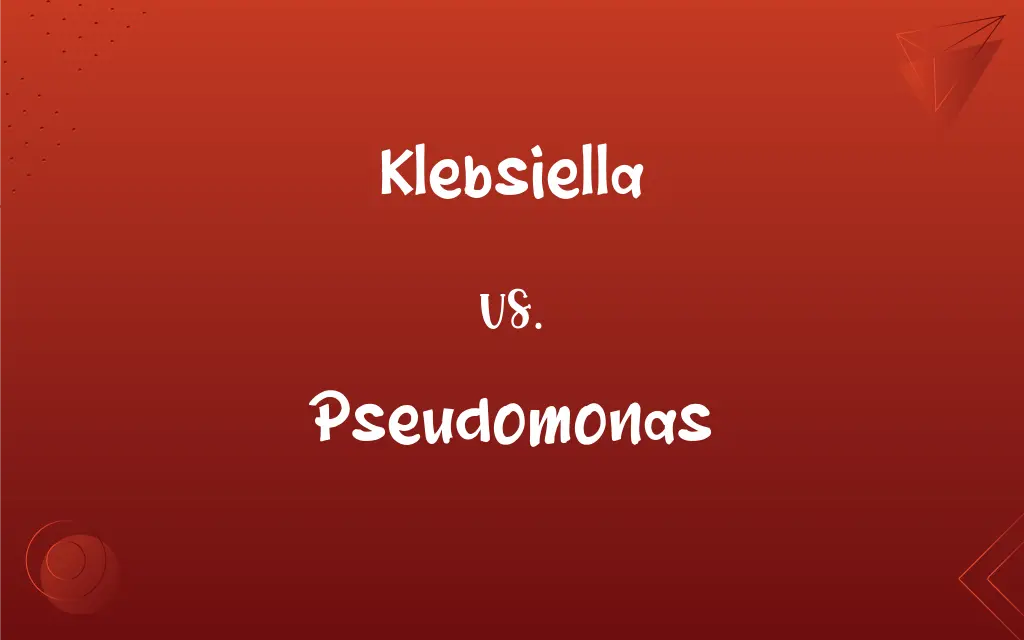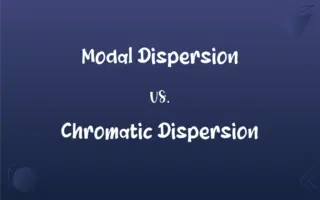Klebsiella vs. Pseudomonas: What's the Difference?
Edited by Aimie Carlson || By Janet White || Published on August 6, 2024
Klebsiella and Pseudomonas are both genera of bacteria, differing mainly in their environments and impacts on human health.

Key Differences
Klebsiella is a genus of bacteria known for causing hospital-acquired infections, such as pneumonia and urinary tract infections. These bacteria are often found in the human gut, where they typically live without causing disease. Pseudomonas, on the other hand, is a genus of bacteria that is known for its environmental versatility and ability to degrade pollutants. Pseudomonas aeruginosa, one of the most studied species, is an opportunistic pathogen that can cause infections in individuals with weakened immune systems.
Both Klebsiella and Pseudomonas are of significant concern in healthcare settings due to their resistance to multiple antibiotics. Infections caused by these bacteria can be severe and are more challenging to treat because of this resistance. Both genera are subject to ongoing research, focusing on understanding their resistance mechanisms and developing new treatment strategies.
Klebsiella species are encapsulated bacteria, which contributes to their virulence by protecting them from the host's immune response. This characteristic allows them to cause more severe infections, particularly in individuals with compromised immune systems. The capsule is a key target for vaccine development.
Pseudomonas species, especially Pseudomonas aeruginosa, are known for their ability to form biofilms, which are communities of bacteria that adhere to surfaces and are encased in a protective matrix. This ability contributes to their persistence in the environment and resistance to antibiotics, making infections difficult to eradicate.
Comparison Chart
Primary Habitat
Human gut and healthcare settings
Soil, water, and environment
ADVERTISEMENT
Common Infections
Pneumonia, UTIs
Respiratory, skin, UTIs
Antibiotic Resistance
High, with many strains resistant
High, particularly in biofilms
Virulence Factor
Capsule that evades immune system
Ability to form biofilms
Environmental Impact
Limited ecological role
Degradation of pollutants
Klebsiella and Pseudomonas Definitions
Klebsiella
Gram-negative, rod-shaped bacteria found in the human microbiota.
Klebsiella is part of the normal gut flora but can be pathogenic.
ADVERTISEMENT
Pseudomonas
A genus of bacteria known for its environmental versatility and opportunistic infections.
Pseudomonas was isolated from the contaminated water source.
Klebsiella
Can lead to severe pneumonia and bloodstream infections if untreated.
Klebsiella pneumonia can be fatal in immunocompromised patients.
Pseudomonas
Known for forming biofilms, contributing to its resistance to antibiotics.
The Pseudomonas biofilm made the infection difficult to treat.
Klebsiella
A genus of bacteria known for causing hospital-acquired infections.
The outbreak was traced to a strain of Klebsiella in the ICU.
Pseudomonas
Pseudomonas aeruginosa is a major cause of hospital-acquired infections.
The burn unit patient developed a Pseudomonas infection.
Klebsiella
Notorious for its antibiotic-resistant strains, complicating treatment.
The patient's infection was caused by a highly resistant Klebsiella.
Pseudomonas
Commonly found in soil and water, capable of degrading various pollutants.
The cleanup used Pseudomonas to break down the oil spill.
Klebsiella
Associated with nosocomial infections, especially in critical care units.
Klebsiella infections are a significant concern in hospital settings.
Pseudomonas
Can infect plants, animals, and humans, showing a broad host range.
Pseudomonas syringae causes disease in a variety of plants.
Klebsiella
A nonmotile, gram-negative, rod-shaped bacterium of the genus Klebsiella, such as K. pneumoniae, that causes pneumonia and other infections usually in patients with diminished immunity, such as diabetics and alcoholics.
Pseudomonas
Any of various gram-negative, rod-shaped, mostly aerobic flagellated bacteria of the genus Pseudomonas, commonly found in soil, water, and decaying matter, and including some plant and animal pathogens.
Klebsiella
Any of the genus Klebsiella of rod-shaped bacteria, which cause many diseases in humans.
Pseudomonas
A pseudomonad.
Klebsiella
A genus of nonmotile rod-shaped gram-negative enterobacteria; some cause respiratory and other infections
Pseudomonas
Type genus of the family Pseudomonodaceae
FAQs
What infections does Klebsiella cause?
It can cause pneumonia, urinary tract infections, and bloodstream infections, among others.
Why is Klebsiella a concern in hospitals?
Because it can cause severe infections, particularly in people with weakened immune systems, and it is often resistant to multiple antibiotics.
What is Klebsiella?
Klebsiella is a genus of bacteria, some species of which can cause infections in humans, particularly in healthcare settings.
What makes Pseudomonas infections challenging to treat?
Its ability to form biofilms and its resistance to many antibiotics make it a challenging pathogen.
How is Klebsiella transmitted?
It is often transmitted through person-to-person contact or from contact with contaminated surfaces.
Is Klebsiella part of normal flora?
Yes, it can be part of the normal gut flora without causing disease.
Can Klebsiella infections be treated?
Yes, but treatment can be complicated due to its resistance to many antibiotics.
How does Klebsiella gain antibiotic resistance?
Through the acquisition of resistance genes from other bacteria and mutations.
Are Klebsiella infections contagious?
Yes, especially in healthcare settings through person-to-person transmission or contaminated equipment.
What are common infections caused by Pseudomonas?
Pseudomonas aeruginosa can cause respiratory infections, skin infections, and urinary tract infections, especially in people with weakened immune systems.
What is Pseudomonas?
Pseudomonas is a genus of bacteria known for its environmental versatility and ability to cause opportunistic infections.
Where is Pseudomonas found?
It is commonly found in soil, water, and various environments, including hospitals.
How can Klebsiella infections be prevented?
Through strict hygiene practices, especially in hospitals, and careful use of antibiotics.
What role does Pseudomonas play in the environment?
It plays a role in nutrient cycling and can degrade pollutants.
Can Pseudomonas infections be prevented?
Good hygiene and proper care of wounds and medical devices can reduce the risk.
What is the treatment for Pseudomonas infections?
Treatment often involves a combination of antibiotics, but options may be limited due to resistance.
Can Pseudomonas infect healthy individuals?
It primarily causes infections in people with weakened immune systems, but it can infect healthy individuals in certain cases.
How do Pseudomonas form biofilms?
By adhering to surfaces and producing a protective matrix, making them more resistant to treatments.
Do Klebsiella and Pseudomonas share resistance mechanisms?
Both can share some resistance mechanisms, like efflux pumps and beta-lactamases, but their profiles may vary.
Can Klebsiella and Pseudomonas co-infect a patient?
Yes, co-infections can occur, especially in hospitalized patients with compromised immune systems, making treatment more complex.
About Author
Written by
Janet WhiteJanet White has been an esteemed writer and blogger for Difference Wiki. Holding a Master's degree in Science and Medical Journalism from the prestigious Boston University, she has consistently demonstrated her expertise and passion for her field. When she's not immersed in her work, Janet relishes her time exercising, delving into a good book, and cherishing moments with friends and family.
Edited by
Aimie CarlsonAimie Carlson, holding a master's degree in English literature, is a fervent English language enthusiast. She lends her writing talents to Difference Wiki, a prominent website that specializes in comparisons, offering readers insightful analyses that both captivate and inform.






































































